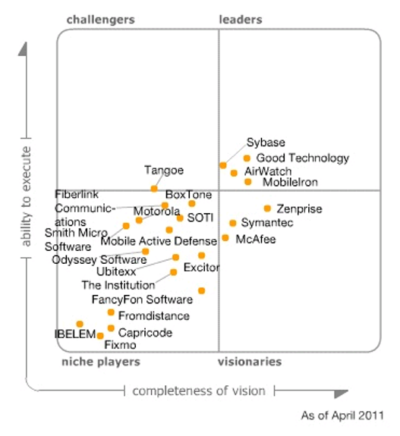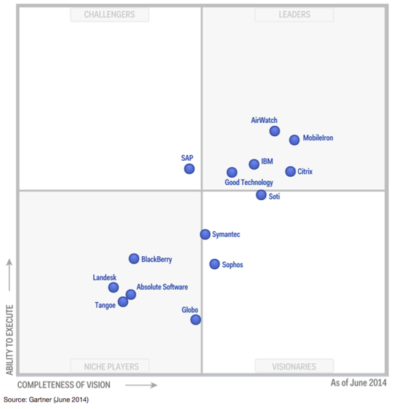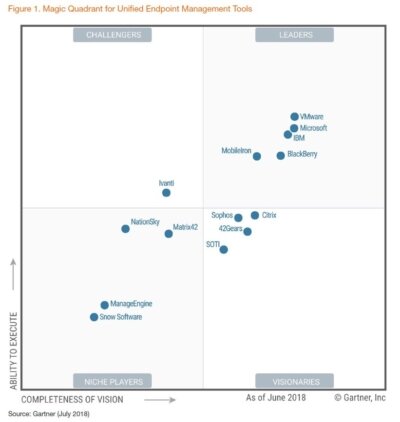
Mobile Device Management (MDM)
“Modern Management has become the standard for a cloud-first and mobile-first modern workforce.”
Over the past 10 years we have witnessed an incredible journey that tells the story of our industry through a series of rapid innovations. I have had the good fortune of being in a ring-side seat, observing and participating along the way so I could talk about this for hours. But, here is a 5-minute summary and a provocative personal vision for the future.
2011 was the official beginning of the MDM category with the release of the first Gartner Magic Quadrant. 23 vendors were selected from over 100 companies doing some form of Mobile Device Management (MDM). There were 4 clear leaders: MobileIron, AirWatch, Good Technology and Sybase. Microsoft was not a contender in 2014.

Enterprise Mobility Management (EMM)
Just 3 years later in 2014, Gartner decided to rename the category to Enterprise Mobility Management Suites (EMM) due to the addition of app management and content management to mobile device management. This reduced the number of companies making the cut from 18 the year before to just 14.

In 2014 there were 5 leaders in MobileIron, AirWatch, IBM, Citrix and Good Technology. Two of the 5 leaders had ‘acquired’ their way into the leaders quadrant with IBM acquiring Fiberlink and Citrix acquiring Zenprise. Fiberlink and Zenprise had both been in the leaders quadrant in 2012 and 2013. Microsoft was still absent from the magic quadrant.
Unified Endpoint Management (UEM)
In 2018 Gartner renamed the category to Unified Endpoint Management Tools (UEM). This was primarily due to the ability to manage Windows and macOS alongside iOS and Android from a single system. Historically Windows machines were managed by SCCM and Macs were managed by proprietary tools like JAMF. UEM gave IT the ability to manage any device by deploying an OTA (over-the-air) profile with policies, permissions, certificates and apps.

The 5 leaders in 2018 were as followed with the name of the original company in parenthesis to show the acquisitions. VMware (AirWatch), IBM (Fiberlink), BlackBerry (Good), Microsoft and MobileIron. Only Microsoft and MobileIron had organically earned their way into the magic quadrant and Microsoft had gone from zero to hero in just 3 years.
Modern Management
Modern Management is a concept introduced by Microsoft which leverages EUM to deliver real-world benefits. It effectively means that we can manage desktops and laptops like a smartphone with granular polices and permissions.
Modern Management replaces ‘legacy management’, which was defined by SCCM, gold images, GPOs, deployment packages and domain joined machines. With Modern Management, profiles and updates are deployed over-the-air (OTA) to devices which removes the need for devices to be inside a security perimeter or domain-joined. This is critical for sending urgent security patches to mobile workers who may not be in an office for weeks.

Modern Management treats all devices as untrusted until they meet pre-defined criteria and are permitted to access sensitive data.
Modern Management also facilitates zero-touch provisioning leveraging Windows Autopilot alongside Apple’s Business Manager or Android’s Zero Touch. This means devices can be ordered and shipped directly to the user and remotely configured out of box with the all required security settings, applications, drivers and content.
Fast forward to 2020. Modern Management has become the standard for a cloud-first and mobile-first modern workforce. The capabilities above have dramatically improved the employee experience with provisioning, enrolling, updating and managing their devices.
The implications for endpoint management costs are equally dramatic with most research showing over 50% cost reduction on legacy management with images, GPOs and packages.
Where to from here?
This is a brutal industry. I have personally owned a Palm PDA, a Mororola Razr, a couple of BlackBerry devices, countless Nokia phones and even a Pebble smartphone. These products represented fame and fortune for a few short years. I feel like this is a déjà vu moment.
My prediction is that we will see Microsoft charge ahead and become a powerhouse for both endpoint security and endpoint management. I expect other strong players like VMware and MobileIron will defend profitable niches, but the mass market will go to Microsoft who will dominate security and productivity like they did with desktop software.
However, once everyone is fully in the cloud, I expect the pendulum will reach its apex and swing back the other way. We might see a return to on-premise software, perhaps a tightly integrated suite of applications to serve the needs of a company. We might even see the return of perpetual licenses to reduce Opex and escape the inevitable annual increase that will happen with cloud services. Or I might be totally wrong. Let’s see….




